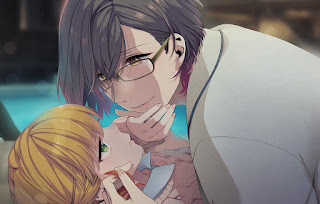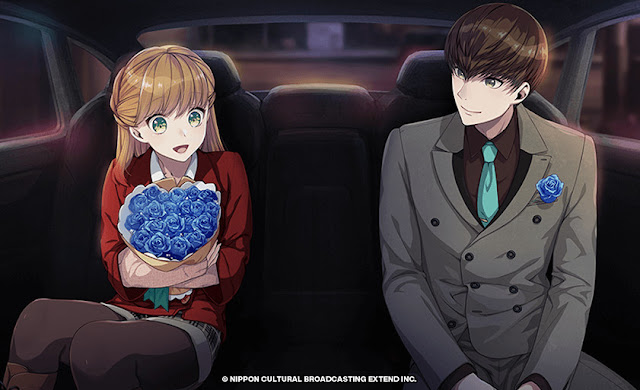Bustafellows is right up there with the best crime fiction works I’ve ever read. Not just in terms of visual novels, or broader video games. I’m talking across all media. Bustafellows is every bit the page-turner of a Conan Doyle or Christie novel. It’s as interesting in terms of its moral musings as anything from Chandler or classic noir cinema such as Chinatown. The serialised, sustained, character-driven nature of it helps make the narrative arcs as compelling to follow as anything Law & Order has ever offered fans, while the pervasive humour gives it the same quirky quality as a Castle or Bones.
And yet the first real impression that this game left on me was that it was, somehow, Quantum Leap. If you haven’t heard of that before, don’t worry. Quantum Leap was an early 90’s TV series that won’t be remembered by anyone who wasn’t there for it. The show, however, was actually quite fun, as it focused on a person who developed the ability to time jump, and found himself thrown back to different eras and situations to help right historic wrongs. With the assistance of a scientist from the modern era, this time leaper knew what went wrong (someone was incorrectly convicted for murder – that kind of stuff), and needed to work out how to change history to be more just, while occupying the body of a person involved in the injustice.
Bustafellow’s most unconventional mystery future is actually a limited form of just that ability. Hercule Poirot was an eccentric genius and Philip Marlowe had an acid tongue, but none of these characters had time travel on their side. The main protagonist of Bustafellows, “Miku” (I called her Miku, and was amused greatly when her best friend in the game was named Luka. I had no idea that was going to play out so perfectly ahead of starting the game) has the ability to jump back in time a few minutes, and subsequently end up in the body of a complete stranger. The first time she uses this ability is to save the life of one of the ultra-cute boys that she ends up grouping up with, and, after subsequently proving that her ability is legitimate, starts using it to help out this little group with the various stunts that they pull.
This group, which includes a “corrupt lawyer,” a computer hacker, an assassin, a plastic surgeon and a coroner, are a group of morally conflicted heroes that align themselves against the various criminal elements abound in the city of New Sieg (a pretty clear mirror to New York). They rob and foil the criminal underbelly of the city, but they’re not exactly a crew of Robin Hoods – the loot that they get from their ventures is money to split between themselves alone. The keyword to all of this is “dangerous,” and the Bustafellows crew is certainly that. They’re frequently playful and have a generally irreverent and relaxed attitude to everything and everyone around them, but the stakes that they involve themselves in are high indeed.
What I found really interesting is just how committed Bustafellows is to directly asking players hefty moral questions. The core linking theme between them is how sometimes the path of righteousness and justice are not aligned with the social and legal systems that we have in place. To press this theme, the game outright asks players questions about how they would respond to situations, who the guilty party is in a hypothetical, and so on. Many of the questions are actually quite difficult (philosophically, not mechanically) and the emphasis on exposing the grey areas in society gives the game a heavy noirish edge, even if the visual aesthetics aren’t quite the Venetian blinds and high contrast shadows that we generally associate with Raymond Chandler’s ballpark.
The only downside to Bustafellow’s brilliant set-up, characterisation, and the questions that it throws at players is that there is just too much in this game. It’s mitigated to an extent because the various chapters are presented like episodes in your favourite crime drama, and it’s pretty well-paced with few dragging lulls, but despite that, the narrative goes on, and on, and on, and it hits the point where it relies far too heavily on twists and turns to sustain it. This is nothing against any of those twists and turns – individually they’re all exciting, page-turning stuff, but the overall impact of the narrative is deadened a little by it being long enough to have a desensitising effect.
Because Bustafellows is an otome, you naturally get plenty of different boys to woo. At first, I wasn’t sure about this side of things. On a practical level, none of the character designs were really that interesting to me on first impressions (the likes of Code: Realize, Haukouki Piofiore and Steam Prison both have much more gorgeous, distinctive character designs, leaving this one feeling a small step backwards in terms of presentation). On a more thematic level, the narrative does come across as “Miku” being more or less forced by circumstance into a wolves’ den filled with men, and coupled with the usual otome CGs in which the girl is being pinned, held, or otherwise dominated by the man, the journey into romance comes across as a touch too close to an uncomfortable Stockholming this time around. That being said, the banter between the characters did eventually win me over anyway, and for the record, Helvetica is mah dude. I mean, sure the name is terrible (because that is one boring font), but that bloke is smooth. My “Miku” sure did swoon hard for him… ahem, anyhow, Bustafellows does take its sweet time to get into the romance stuff proper, to the point that I was almost certain that it would be a token afterthought to the rest of the drama. By the time it does get there, you’re going to be well and truly ready for “Miku” to be swept off her feet.
While I wasn’t overly sold on the character designs, the backgrounds do a breathtaking job of setting the scene. These are beautiful, distinctive and interesting environments that do fully sell the various blends of crime fiction that the narrative pushes. They often say that in crime fiction, the setting itself is a critical character, if not the most important character of all, and New Sieg is one I hope gets used again in the future. In visual novels the role of the background is often… backgrounded, but here it really is core to so much of the experience.
Bustafellows is part crime caper and part otome romance, and those are common enough things, but it’s the quality of the writing and the strong thematic core that helps to set this one apart. It might be perhaps a little too long for its own good, and so some of the impact of it is softened via desensitisation, but even then, there’s no real lull in the storytelling, and it’s one of those rare lengthy games that isn’t simply throwing content at players. The best crime fiction stories are page-turners, filled with excitement and drama. Bustafellows adds several proverbial tonnes of charm, humour and panache into the mix, and thanks to all of that, it is one of the most dynamic and exciting visual novels you can find.










